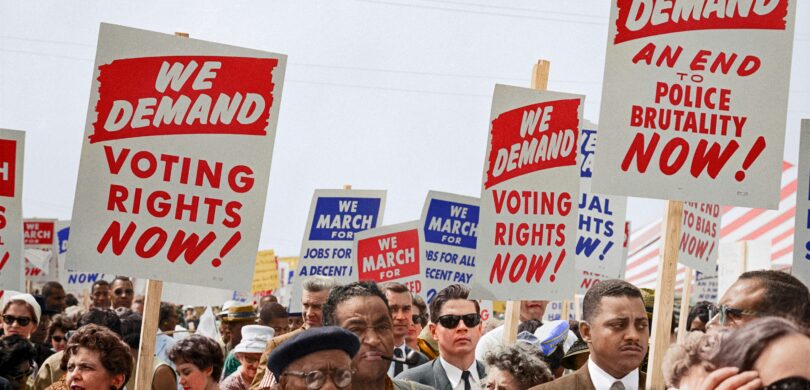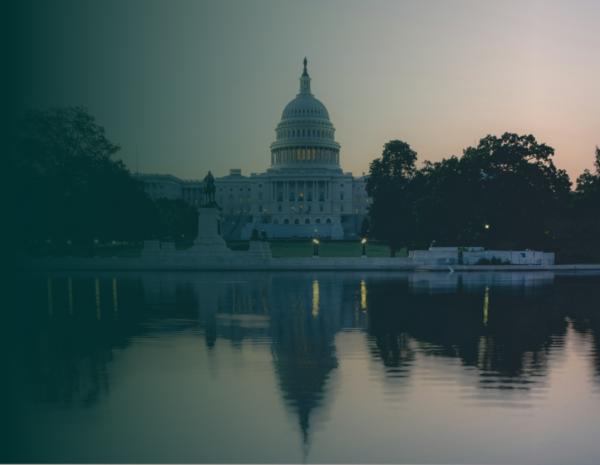The Declaration of Independence famously reads, “all men are created equal,” but all were not granted equal voting rights when the United States began. Many men could not vote for the leaders of their new nation. Women could not vote at all for some time after those words were written in 1776.
As the country grew, so did its voting rights, moving closer to the ideals of the Declaration. Today nearly all adult U.S. citizens have a legal right to vote. Read on to learn more about the expansion of voting rights throughout the country’s history.
The Evolution of Voting Rights in the US
Voting rights in the United States have evolved over time with the passage of new election laws and Constitutional amendments.
Voting Rights in the 1700s and 1800s
In the late 1700s, most states restricted voting rights to white male property owners older than 21. They began to remove the property ownership requirement in the early 1800s, and by the 1820s, it was no longer common.
The next major change to voting rights came at the end of the Civil War. In 1865, the 13th Amendment to the U.S. Constitution ended slavery nationwide. The 14th Amendment then granted citizenship and equal protection under the law to “all persons born or naturalized in the United States,” including former slaves.
In 1870, the 15th Amendment extended voting rights to Black men. They would face a long struggle before they could exercise it freely.
In the meantime, women were beginning their own fight for the right to vote. Wyoming was the first to grant it to women in 1869. One by one, more states allowed women to vote, but most still banned it during the 19th century.
Voting Rights in the 1900s
While the expansion of voting rights had already begun, many Americans wouldn’t see true change until the 1900s.
Women’s Suffrage Movement
The women’s suffrage movement in the U.S. began in the mid-1800s. Supporters protested, marched, and lobbied for women’s right to vote. Women still could not vote nationwide the 19th Amendment was ratified in 1920. Even then, Black women still faced the same obstacles to voting as Black men did.
Civil Rights Movement
While Black men were granted the right to vote by law in 1870, most still could not vote well into the 20th century. Many states, especially in the South, quickly put up barriers to voting that targeted Black citizens. Poll taxes required payment to vote, and Black voters were less likely than white voters to be able to pay them. Literacy tests also disadvantaged Black citizens, whose educational opportunities were limited. The requirements were often waived for white voters. Some states enacted “grandfather clauses,” which exempted people from these laws if they or their ancestors could vote before 1866 or 1867.
In the 1960s, the Civil Rights Movement challenged these and other discriminatory laws. Black Americans and their allies fought for equality through years of protests, marches, and civil disobedience. As a response, Congress passed the 24th Amendment to the Constitution, which banned poll taxes. Congress then got to work on civil rights legislation.
In 1965, President Lyndon B. Johnson signed the Voting Rights Act, which banned literacy tests and enforced the 15th Amendment. Johnson had told Congress that these “literacy tests” sometimes required Black voters to recite the Constitution or explain complex state laws. Since its passage, several amendments to the Voting Rights Act have extended it and added protections for voters. Notably, a 1975 change required districts with a significant non-English-speaking population to provide ballots and information in the language of that population.
Native Americans and Asian Americans
Some Native Americans already had citizenship by 1924, but that year, the Indian Citizenship Act granted all Native Americans citizenship and the right to vote. Some states still prevented them from voting for a few decades.
The Magnuson Act of 1943 gave Chinese immigrants the right to citizenship and, thus, the right to vote. In 1952, the McCarran-Walter Act granted these rights to all Americans of Asian descent.
Youth Rights Movement
Efforts to lower the minimum voting age started in the 1940s, but they didn’t gain momentum until the 1960s. The military draft during the Vietnam War sparked a youth rights movement. Voters had to be 21 to vote in most states, but they could be conscripted into military service at 18. Advocates pointed out that young men were being sent to war without the ability to vote for the people who decided to wage it. In 1971, the 26th Amendment established a national voting age of 18.
Protections For Voters With Disabilities
The Voting Accessibility for the Elderly and Handicapped Act of 1984 set nationwide requirements for accessibility in the federal election process. It mandates that all polling places must be accessible to people with disabilities and the elderly. If no accessible location is available, voters must have an alternate means of voting on Election Day. The law also requires each state to provide ballots printed in a large font and voting aids for the deaf and hard of hearing.
Motor Voter Act
In 1993, Congress passed the National Voter Registration Act of 1993, also known as the “Motor Voter Act.” This law includes several provisions intended to make voter registration easier. It requires states to allow people to register to vote when they apply for or renew their driver’s license or apply for public assistance. States must also offer mail-in voter registration applications.
Voting Rights in the 21st Century
The 21st century began with further expansions of voting rights and improvements in the election process. Later, though, two U.S. Supreme Court rulings weakened key provisions of the Voting Rights Act.
Convicted Felons and Prisoners
In the first decade of the 2000s, many states began to lift restrictions on voting for convicted felons. People with felony convictions had typically been banned from voting for life. Now, most states restore voting rights after prisoner release, probation, or parole. Some set conditions on restoration, and two – Kentucky and Virginia – require felons to petition for it. Maine, Vermont, and Washington, D.C., allow prisoners to vote while they are in prison.
Help America Vote Act of 2002
The 2000 presidential election was especially contentious. The result came down to Florida, where George W. Bush won over Al Gore by a thin margin. State law required a recount, bringing attention to ballots that had been rejected for errors. Some counties in Florida used punch-card voting machines, which some voters had difficulty using. The machines also did not fully punch the ballot card at times, causing the counting system to reject those ballots. Gore contested the election and requested a manual recount in four counties, but the U.S. Supreme Court ruled against him.
In response to this controversy, Congress passed the Help America Vote Act of 2002. The law required states to replace punch card or lever voting systems with newer systems. It also created the Election Assistance Commission and set minimum standards for election administration.
Weakening of the Voting Rights Act
In the 2013 case Shelby County v. Holder, the Supreme Court ruled that Section 4(b) of the Voting Rights Act was unconstitutional. As a result, states with a history of voting rights violations no longer had to seek federal review to make changes to their voting systems.
In 2021, the Supreme Court weakened Section 2 with its ruling in Brnovich v. Democratic National Committee. Section 2 reads, “No voting qualification or prerequisite to voting or standard, practice, or procedure shall be imposed or applied by any State or political subdivision in a manner which results in a denial or abridgment of the right of any citizen of the United States to vote on account of race or color.” While they did not overturn it, the Court set standards that made it harder to challenge voting laws based on this section.
Where Voting Rights Stand Now
Current voting rights issues commonly relate to voter identification laws and other potential barriers to voting. Over the nation’s history, many states changed their systems to make it easier to vote. Absentee, mail-in, and early voting offer citizens the chance to cast ballots without having to go to a polling place on Election Day. In recent years, though, some states have restricted these methods of voting – sometimes while closing polling places.
Several states also have passed voter ID laws in the 21st century. Supporters say requiring voters to show photo identification is necessary to prevent voter fraud. Opponents say fraud is extremely rare and that these laws make voting harder for poor people and voters of color.
Voting rights advocates fight against restrictions that could disenfranchise protected groups. They may also fight for election reforms, including changes to voting methods, redistricting methods, the electoral college, and more.
Register To Vote
Now that you know more about voting rights, if you are a United States citizen, you can get ready to exercise them. (Some states allow non-citizen residents to vote in local or state elections, too.) All states except North Dakota require voters to register before casting a ballot. The registration deadline varies by state, but according to the Motor Voter Act, it must be no more than 30 days before a federal election. In some states, voters can register during early voting times or even on Election Day.
To register to vote, enter your state or territory at vote.gov. This website will give you information about voter registration in your state, including the ways you can register and the deadline. Usually, you can register online through your state’s Board of Elections website. Other options include registering by mail or in person.
Get Started With Plural
As the 2024 election nears, understanding the history of voting rights as well as how to vote is especially crucial. At Plural, we’re committed to helping public policy teams, advocates, and citizens alike understand government and legislation. Create a free account today to:
- Search legislative data from 53 US jurisdictions: 50 states, Washington, D.C., Puerto Rico, and U.S. Congress
- See comprehensive bill details, state-specific data, and legislator information
- Easily track bills and never miss an update
- Receive daily updates on the bills you’re monitoring
More Resources for Public Policy Teams
Key Benefits of AI for Lobbying & Advocacy
Want to be able to explain the benefits of artificial intelligence for lobbying and advocacy? Everyone is talking about AI. And we get it, it’s not simple to understand. But as an AI-powered organization, Plural is here to help you get the most out of advancements in AI to make your job as a policy […]
2025 Legislative Committee Deadlines Calendar
Staying on top of key deadlines is manageable in one state, but if you’re tracking bills across multiple states, or nationwide, it quickly becomes overwhelming. That’s why we created the 2025 Legislative Committee Deadlines Calendar. Stay ahead of important dates and download our calendar today. Get started with Plural. Plural helps top public policy teams get […]
End of Session Report: Florida 2024 Legislative Session
The 2024 Florida legislative session saw significant activity in the realm of insurance and financial services, reflecting key themes of consumer protection, market stability, and regulatory modernization.




